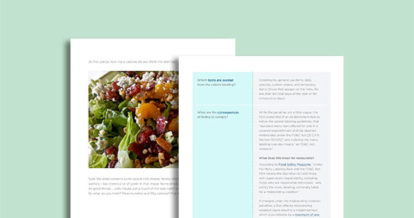A Primer on the FDA’s Menu Labeling Guidance for Restaurateurs
Salad is always the healthiest choice – right? If only it were that easy!
The Food and Drug Administration’s (FDA) Menu Labeling Final Rule requires restaurants to list calories for menu items to help diners make more informed decisions. But who do these new rules apply to? What on your menu requires labeling? How do you label it? This guide to the FDA’s menu labeling rule for restaurants answers all your pressing questions.
Download this free guide to gain answers to frequently asked questions about the FDA’s menu labeling rules, learn the pros, cons, and complexities of labeling your menu, and find out how to prepare your restaurant for menu labeling. Here’s a sneak peek of what you’ll learn in the guide.
FAQs About the FDA’s Menu Labeling Guidance for Restaurants
According to the FDA’s menu labeling guidance, any restaurant or similar retail food establishment with 20 or more locations has to list the number of calories in each menu item. This policy seems simple, but is actually quite intricate.
In addition, the FDA also outlines nine major food allergies, which you can refer to when considering your menu design and using a food allergen matrix can help with this process.
Our guide to the FDA’s menu labeling policy answers frequently asked questions about this rule, including:
- Who does it apply to?
- What are some examples of “restaurant-type food” affected?
- Does the rule apply to alcohol?
- How do food establishments gather caloric information?
- How must restaurants display caloric information?
- Are there formatting requisites for the calorie label?
- Which items are exempt from calorie labeling?
- What are the consequences of failing to comply?
Pros, Cons, and Complexities of Labeling Your Menu
Next up in our guide to the FDA Menu Labeling Final Rule are the pros, cons, and political complexities of this policy.
We weigh the benefits and downsides of the rules in detail, such as:
- Pro: Consumers can trust that restaurants will be more transparent
- Con: The FDA’s menu labeling guidance assumes all calories are created equal
- Pro: Restaurants may consider smaller portion sizes
- Con: The transition and maintenance of displaying calories is expensive and complicated for restaurants
We also discuss the politics behind the FDA Menu Labeling Final Rule. The Menu Labeling Final Rule was established as part of the Obama administration’s Affordable Care Act (ACA or Obamacare). As the Trump administration took office and introduced the plan to repeal and replace Obamacare with the American Health Care Act (AHCA), the future of the menu labeling rule became uncertain because it was not included in the AHCA.
How did this change affect the Menu Labeling Final Rule? Download the guide to learn more.
How to Prepare Your Restaurant for FDA Menu Labeling
While menu labeling is an onerous task for restaurant chains and franchisors, there are some tools you can use to make the transition and the maintenance of calorie counts easier. Our guide helps you understand options like:
- Calorie-counting software
- Agile menu development
- Hiring a nutritionist
Like with most regulations, the FDA’s Menu Labeling Final Rule is complicated to understand. Fortunately, we’ve done the hard work of interpreting this policy for you. Download our free Complete Guide to the FDA’s Menu Labeling Rule today.
The FDA also has common allergies that you can include as part of your menu labeling if it applies to your menu items and a food allergen matrix can help your staff protect the safety of your guests, specifically those with food allergies.




